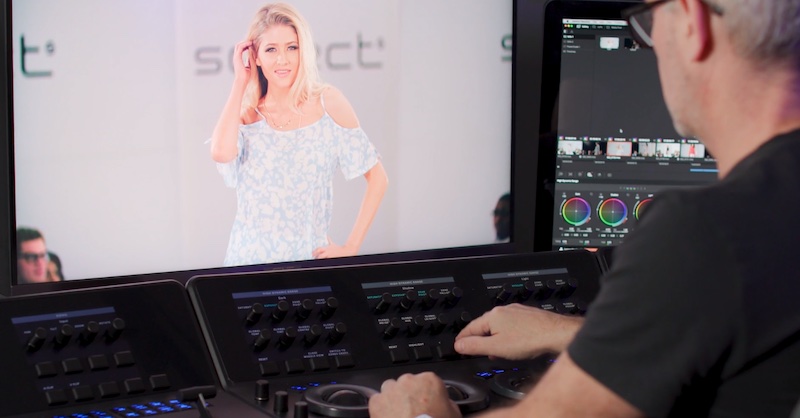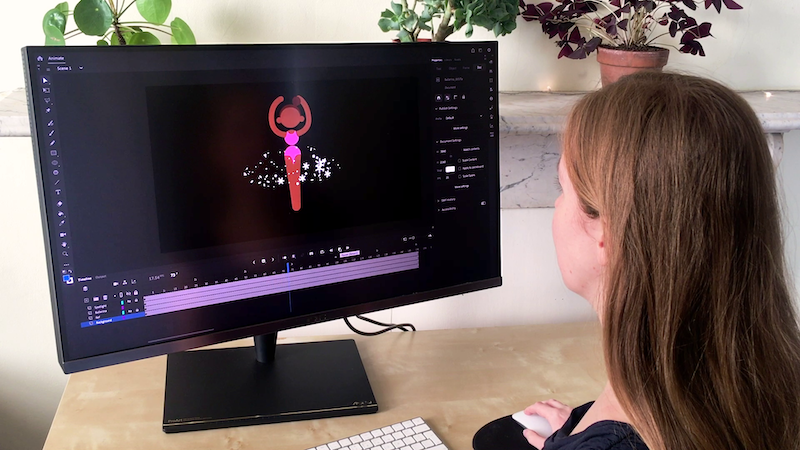
Computer monitors with professional level performance are now available for a small fraction of the “traditional” price. We asked four freelance content creators - a colourist, a cinematographer, an animator and a high concept filmmaker what their ideal monitor would be. In association with Asus.
Creative professionals have a different relationship with their computer monitors to, let’s say, accountants or town planners. For anyone that works with words and numbers, the absolute image quality of a monitor is less important than clear text and diagrams. To put it bluntly, it doesn’t matter if a spreadsheet looks a bit pink, because it doesn’t affect the numbers.
For visual artists, it’s very different. It might sound strange, but you can compare the role of a monitor to a camera lens. Every single characteristic of a lens is “burnt in” to the images it makes, and it’s the same with a professional monitor: any errors in a grading monitor’s rendition of a scene will be “burnt in” to the images forever, by misguiding the colourist.
So is a monitor really as important to a visual artist as a camera lens is to a cinematographer?
We asked four visual artists about the role a professional monitor plays in their working lives.
All of these creative professionals use an ASUS PA32UCX, a 32” 4K HDR calibrated monitor with variable mini LED backlighting and a maximum brightness of 1,200 nits (Peak).
 Hasraf “HaZ” Dulull is a successful Netflix-hosted filmmaker with a background in Visual Effects for Film and TV.
Hasraf “HaZ” Dulull is a successful Netflix-hosted filmmaker with a background in Visual Effects for Film and TV.
 Darren Mostyn is a renowned colourist with 20 years experience in the broadcast industry. He now runs Online Creative, a digital agency and boutique post facility in Central Brighton
Darren Mostyn is a renowned colourist with 20 years experience in the broadcast industry. He now runs Online Creative, a digital agency and boutique post facility in Central Brighton
 Julia Young is an in-demand rigger and animator working for the UK’s national networks in children's programs.
Julia Young is an in-demand rigger and animator working for the UK’s national networks in children's programs.
 Brett Danton is a multi-talented Director, Cinematographer and Photographer His current (secret) project is for a car manufacturer, and is pushing digital filmmaking technology beyond all known limits.
Brett Danton is a multi-talented Director, Cinematographer and Photographer His current (secret) project is for a car manufacturer, and is pushing digital filmmaking technology beyond all known limits.
Can you describe your ideal working setup? What are the elements that are important to you?
Darren
We use large, specialist desks that are ergonomic and have built in rack mounting. With neutral walls, specialist bias lighting total blackout, we have perfect grading conditions, with access to daylight when not grading. Powerful Mac Pro machines and fast servers give us true 4K workflows. There’s a dedicated “advanced” DaVinci panel for the grading suite and calibrated monitoring for accuracy.
Julia
The most important thing for me is that my setup is ergonomic and that I have the most reliable equipment that I can afford. There's nothing worse than not being sure you're seeing your work accurately, or racing for a deadline and suddenly something stops working!
Brett
I need to work between all my applications and view on the same source for accuracy across multiple platforms, photoshop and resolve are the two main applications I use. Colour accuracy and depth are the most important to me. A constant light that is not too bright and stays even no matter what the time of day is.

Darren Mostyn at work.
How much time do you spend each day looking at your monitor?
Julia
All of my working time. That’s eight hours plus per day. I do all my work and I see it through my monitor. I can't work without it.
HaZ
My optometrist asks me that! I would say around 70% of my working day is spent looking at my monitor, working with concept art, photoshop blocking out scenes, or animating and lighting scenes in Unreal engine.
What resolutions are you working at?
Julia
A lot of what I do is resolution independent because it’s vector based, but I need to be able to see what I’m doing in the highest possible quality - especially if it’s destined for 4K delivery. With vectors, the higher the resolution, the smoother the curves and diagonals. The project I'm working on at the moment is 4K bitmap and the linework is particularly detailed and important to get right. I spend a lot of time looking at individual pixels!
Brett
I work in 4k all the time, normally with 6k RAW files, finishing in both HDR and SDR. 4k is the perfect pixel density for me viewing my work as it's in the native resolution. Having a 32 inch monitor allows me to have distance from the screen without eye strain, viewing angle is also important especially if I have a client viewing the screen from the side.

Hasraf “HaZ” Dulull in front of his work setup.
How does the quality of your monitor impact the quality of your work?
Darren
It is vital that the monitor is calibrated and accurate to broadcast standards. My work is all around colour and if I don’t have an accurate representation of it I’m working “blind”. Good colour performance means that I can rely on my monitor to give an accurate account of what I’m going to be sending to the broadcasters. I need to see every detail - and every flaw - in the image.
Julia
Colour accuracy and purity are vital. When I get a creative brief, I have to fit in with the overall look of the production. Of course it can always be adjusted in post production, but I prefer to deliver something that’s right first time.
Brett
The monitor is everything to me, if I can’t view what I am making accurately, I’m never going to produce a high quality finished piece, and this reflects directly on my professional reputation.
HaZ
Fidelity in the details and colours is imperative when working in a 4K deliverable environment. We always take our Resolve files to a post facility for the final colour check in P3 on a theatrical screen, as well as high end monitors. Of course, I want to see the same quality and accuracy on my home monitor.
I need to be able to have that level of control and confidence as a creator. When I produce content that will be seen on multiple display types (TVs, phones, tablets etc), the quality that viewers see is directly related to the quality of my own monitor.

Julia Young at work.
How would you describe your relationship with your monitor
Darren
It’s critical. It’s the window on my creative world. If something is wrong because of a badly calibrated or inaccurate monitor, it’s with the content forever. Scopes help but they can’t show the effect of a nuanced colour look. So the only way to be certain that I’m delivering content that’s faithful to my ideas and to the production’s artistic intent, is to have a screen that’s as accurate as it can possibly be. I have to be able to trust my monitor.
Brett
Professional quality reference monitors have always been very expensive, I could only judge my images before by going to an expensive post house. Now, I can work confidently from home at a level that would have been impossible previously. it's completely changed my post production workflow
What does it mean to you to have a monitor with a top-end performance at an affordable price?
Darren
It means that my own facility here in Brighton has the same top-level performance as the big grading houses, but keeps it affordable for me and my clients. It literally boosts my business. With HDR for example, we can’t justify spending tens of thousands on a monitor when we get outstanding results for a fraction of the cost, especially at this early stage of HDR adoption.
Julia
I can work from home with the same confidence as working in a facility. Obviously I need to make sure that my ambient conditions are right, and facilities will always have their place at the top end; but it means that I can function to a very high level and keep my expenditure on equipment manageable.
HaZ
It means I am not second guessing when it comes to colour and details on my end, I won’t have to deal with emails from executives or financiers reviewing dailies saying “why does it look milky on my screen or too dark on my screen?”. I need to ensure that I have a display monitor that not only is technically superb but also affordable to an independent production company that doesn’t have huge R&D budgets like the bigger studios do.
Tags: Post & VFX


Comments